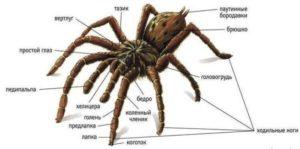What does the body of a spider consist of: internal and external structure
Spiders are constant neighbors of people in nature and at home. They look intimidating due to the large number of paws. Despite the external differences between species and representatives, the anatomy of the spider and the external structure are always the same.
Content
Spiders: general characteristics
Spiders are representatives of the order of arthropods. Their limbs are made of segments, and the body is covered with chitin. Their growth is regulated by molting, a change in the chitinous shell.
Spiders are important members of the biosphere. They eat small insects and thereby regulate their numbers. Almost all are predators living on the ground surface, with the exception of one species.
External structure
The body structure of all spiders is identical. Unlike insects, they do not have wings or antennae. And they have structural features that are distinctive - the ability to make a web.
Body
The body of the spider is divided into two parts - the cephalothorax and abdomen. There are also 8 walking legs. There are organs that allow you to capture food, chelicerae or oral jaws. Pedipalps are additional organs that help capture prey.
cephalothorax
The cephalothorax or prosoma consists of several surfaces. There are two main surfaces - the dorsal shell and the sternum. Appendages are attached to this part. There are also eyes, chelicerae, on the cephalothorax.
Legs
Spiders have 4 pairs of walking legs. They consist of members, of which there are seven. They are covered with bristles, which are organs that capture smells and sounds. They also react to air currents and vibrations. There are claws at the tip of the calf, then they go:
- basin;
- spit;
- hip;
- patella;
- tibia;
- metatarsus;
- tarsus.
Pedipalps
The limbs of the pedipalp consist of six segments, they do not have a metatarsus. They are located in front of the first pair of walking legs. They have a large number of detectors that act as taste and smell recognizers.
Males use these organs to mate with females. They, with the help of the tarsus, which change slightly during maturity, transmit vibrations through the web to females.
chelicerae
They are called jaws, because these limbs perform exactly the role of the mouth. But in spiders they are hollow, with which he injects poison into his prey.
Eyes
Depending on the type eye can be from 2 to 8 pieces. Spiders have different vision, some distinguish even small details and movements, while most see mediocre, and rely more on vibrations and sounds. There are species, mainly cave spiders, that have completely reduced organs of vision.
Peduncle
There is a certain feature of spiders - a thin, flexible leg that connects the cephalothorax and abdomen. It provides good movement of body parts separately.
When a spider spins a web, it only moves its abdomen, while the cephalothorax remains in place. Accordingly, on the contrary, the limbs can move, and the abdomen remains at rest.
Stomach

"Bottom" of the spider.
He is an opisthosoma, has several folds and a hole for the lungs. On the ventral side there are organs, spinnerets, which are responsible for weaving silk.
The shape is mostly oval, but depending on the type of spider, it can be elongated or angular. The genital opening is at the bottom at the base.
Exoskeleton
It consists of dense chitin, which, as it grows, does not stretch, but is shed. Under the old shell, a new one is formed, and the spider at this time stops its activity and stops eating.
The process of molting occurs several times during the life of a spider. Some individuals have only 5 of them, but there are those that go through 8-10 stages of shell change. If the exoskeleton is cracked or torn, or mechanically damaged, the animal suffers and may die.
Internal organs
The internal organs include the digestive and excretory systems. This also includes the circulatory, respiratory and central nervous systems.
The circulatory system is covered. Instead of blood, the body is filled with geolymph, which circulates through the organs with the help of arteries. This liquid has a slightly bluish color, which is provided by hemocyanin, a protein with copper.
The heart is one solid tube, with no chambers or divisions. It is located above the intestines, within the midline of the abdominal cavity.
The respiratory system may differ from spider species. They can have either 2 pairs of lungs or tracheas. There are those that are divided, the front part is light, and the back is transformed into a trachea.
Digestion is considered external. The spider does not digest food inside, but feeds on dissolved syrup. The spider hunts the victim, with the help of an attack or nets, injects poison into it. It usually takes several hours for a nutrient solution to be obtained from the insides of insects.
There is a special nerve mass in the cephalothorax, which can take up to 40% of the total volume. A large number of cerebral nerves depart from it, which diverge in all organs, to the tips of the legs.
Reproduction
Spiders are dioecious animals. Their reproductive organs are located on the lower part of the abdomen. From there, males collect sperm into the bulbs at the ends of the pedipalps and transfer it to the female genital opening.
In most cases, spiders are sexually dimorphic. Males are usually much smaller than females, but brighter colored. They are more interested in breeding, while females often attack suitors before, after and during mating.
Courtship of some species of spiders is a separate art form. For example, tiny peacock spider invented a whole dance that shows the female his intentions.
Conclusion
The structure of the spider is a complex mechanism that is perfectly thought out. It provides existence with sufficient food and proper reproduction. The animal takes its place in the food chain, benefiting people.
Previous
